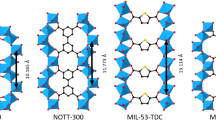Abstract
A convenient method has been proposed for the synthesis of aluminum- and zinc-containing terephthalic acid-based metal-organic frameworks. The method offers high productivity and high product yield. Materials produced by this method have been characterized by physicochemical techniques, and their sorption capacity has been assessed.
Similar content being viewed by others
References
Murray, L.J., Dinca, M., and Long, J.R., Hydrogen storage in metal-organic frameworks, Chem. Soc. Rev., 2009, vol. 38, no. 5, pp. 1294–1314.
Li, J.-R., Kuppler, R.J., and Zhou, H.-C., Selective gas adsorption and separation in metal-organic frameworks, Chem. Soc. Rev., 2009, vol. 38, no. 5, pp. 1477–1504.
Duren, T., Bae, Y.-S., and Snurr, R.Q., Using molecular simulation to characterise metal-organic frameworks for adsorption applications, Chem. Soc. Rev., 2009, vol. 38, no. 5, pp. 1237–1247.
Luo, J., Wang, J., Li, G., et al., Assembly of a unique octa-nuclear copper cluster-based metal-organic framework with highly selective CO2 adsorption over N2 and CH4, Chem. Commun., 2013, vol. 49, no. 97, pp. 11 433–11 435.
Yang, S., Lin, X., Lewis, W., et al., A partially interpenetrated metal-organic framework for selective hysteretic sorption of carbon dioxide, Nat. Mater., 2012, vol. 11, pp. 710–716.
Maes, M., Alaerts, L., Vermoortele, F., et al., Separation of C5-hydrocarbons on microporous materials: complementary performance of MOFs and zeolites, J. Am. Chem. Soc., 2010, vol. 132, no. 7, pp. 2284–2292.
Lee, J., Farha, O.K., Roberts, J., et al., Metal-organic framework materials as catalysts, Chem. Soc. Rev., 2009, vol. 38, no. 5, pp. 1450–1459.
Ma, L., Abney, C., and Lin, W., Enantioselective catalysis with homochiral metal-organic frameworks, Chem. Soc. Rev., 2009, vol. 38, no. 5, pp. 1248–1256.
Ravon, U., Chaplais, G., Chizallet, C., et al., Investigation of acid centers in MIL-53(Al,Ga) for Brönstedtype catalysis: in situ FTIR and ab initio molecular modeling, Chem. Catal. Chem., 2010, vol. 2, no. 10, pp. 1235–1238.
Ferey, G., Some suggested perspectives for multifunctional hybrid porous solids, Dalton Trans., 2009, no. 23, pp. 4400–4415.
Horcajada, P., Serre, C., Maurin, G., et al., Flexible porous metal-organic frameworks for a controlled drug delivery, J. Am. Chem. Soc., 2008, vol. 130, no. 21, pp. 6774–6780.
Horcajada, P., Chalati, T., Serre, C., et al., Porous metal-organic-framework nanoscale carriers as a potential platform for drug delivery and imaging, Nat. Mater., 2010, vol. 9, pp. 172–178.
Cohen, S.M., New approaches for medicinal applications of bioinorganic chemistry, Curr. Opin. Chem. Biol., 2007, vol. 11, no. 2, pp. 115–120.
Cychosz, K.A. and Matzger, A., Water stability of microporous coordination polymers and the adsorption of pharmaceuticals from water, Langmuir, 2010, vol. 26, no. 22, pp. 17 198–17 202.
Allendorf, M.D., Bauer, C.A., Bhakta, R., and Houk, R.J.T., Luminescent metal-organic frameworks, Chem. Soc. Rev., 2009, vol. 38, no. 5, pp. 1330–1352.
Czaja, A.U., Trukhan, N., and Muller, U., Industrial applications of metal-organic frameworks, Chem. Soc. Rev., 2009, vol. 38, no. 5, pp. 1284–1293.
Prokof’ev, V.Yu., Razgovorov, P.B., Zakharov, O.N., and Il’in, A.P., Modified aluminosilicate sorbents for vegetable oil purification, Khim. Khim. Tekhnol., 2008, vol. 51, no. 7, pp. 65–69.
Liu, J., Zang, F., Zou, X., et al., Environmentally friendly synthesis of highly hydrophobic and stable MIL-53 MOF nanomaterials, Chem. Commun., 2013, vol. 49, no. 67, pp. 7430–7432.
Loiseau, T., Serre, C., Huguenard, C., et al., A rationale for the large breathing of the porous aluminum terephthalate (MIL-53) upon hydration, Chem.—Eur. J., 2004, vol. 10, no. 6, pp. 1373–1382.
Férey, G. and Serre, C., Large breathing effects in three-dimensional porous hybrid matter: facts, analyses, rules and consequences, Chem. Soc. Rev., 2009, vol. 38, no. 5, pp. 1380–1399.
Author information
Authors and Affiliations
Corresponding author
Additional information
Original Russian Text © E.A. Vlasova, E.V. Naidenko, E.V. Kudrik, A.S. Makarova, S.V. Makarov, 2015, published in Neorganicheskie Materialy, 2015, Vol. 51, No. 3, pp. 284–288.
Rights and permissions
About this article
Cite this article
Vlasova, E.A., Naidenko, E.V., Kudrik, E.V. et al. Efficient synthesis of aluminum- and zinc-containing metal-organic frameworks. Inorg Mater 51, 236–240 (2015). https://doi.org/10.1134/S0020168515020181
Received:
Published:
Issue Date:
DOI: https://doi.org/10.1134/S0020168515020181




